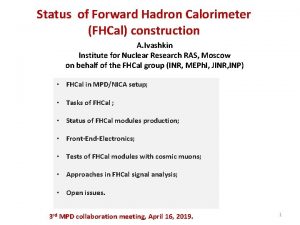Tests of a Digital Hadron Calorimeter Prototype Argonne

- Slides: 1

Tests of a Digital Hadron Calorimeter Prototype Argonne, Boston, Fermilab, Iowa The goal is to develop a hadron calorimeter with extremely fine granularity, which can provide unprecedented imagining capability and measure hadronic showers in great details. The imaging capability is essential for the application of Particle Flow Algorithms (PFAs), which are expected to improve the jet energy resolution significantly in future lepton collider experiments. FE board + DCAL Pad board Data concentrator Data collector PFA Particles in jets Fraction Detector of energy Charged 65 % Tracker Photons 25 % ECAL Neutral Hadrons 10 % ECAL+HCAL To obtain σEjet < 30%/√E Confusion Trigger & Timing module Resolution in Ge. V Negligible 0. 052 Ejet 0. 162 Ejet ≤ 0. 242 Ejet We designed and built an electronic readout system around the DCAL chip which consists of a front-end board (containing 1 cm 2 detector pads and housing the DCAL chips), a data concentrator, a data collector board and a trigger & timing module. T 970: Beam Test of DHCAL Prototype at Fermilab MTBF At MTBF we tested a stack of up to 9 layers of RPCs with a complete electronic readout system (up to 2, 300 readout channels) Particle Flow Algorithms use both tracking and calorimeter information to measure jets. The challenge in this approach is to correctly identify energy deposits in the calorimeter coming from charged and neutral particles. Simulations show that a jet energy a factor ~2 better than obtained with the LEP detectors can be achieved by using PFAs together with a detector optimized for their application. Data set: Broadband μ’s (without momentum tag) e+ of 1, 2, 4, 8, 16 Ge. V/c π+ of 1, 2, 4, 8, 16 Ge. V/c p 120 Ge. V at varying beam rate A hadron calorimeter segmented into 1 cm 2 pads laterally and layer-by-layer longitudinally with digital (single-bit) readout is able to preserve the single particle resolution of hadrons as obtained in the past with analog (multi-bit) readout of towers. Analysis status: The µ analysis has been finished and published. The e+ and π+ analysis and simulation are ongoing and close to publication. Active Medium: Resistive Plate Chamber (RPC) μ tracks We developed Resistive Plate Chambers (RPCs) as active medium of the Hadron Calorimeter. RPCs are simple in design, cheap to built, reliable to operate, highly efficient with low noise rates. The readout can be segmented into small pads with low pad multiplicity for single particles traversing the chamber. Additional details can be found in Response to 2 Ge. V e+ e+ shower π+ shower Positron response G. Drake et al. , Nucl. Instr. Method A 572, 211 (2007) Digital Readout System The most challenging part of this project is the electronic readout system which needs to handle a huge number of channels (~107 for an ILC experiment). Our approach is a system built around a custom ASIC. We designed and prototyped a front-end ASIC (the DCAL chip) which reads out 64 individual channels and provides a hit pattern together with a time stamp (100 ns resolution). Outlook We initiated the construction of a 1 m 3 physics prototype to test the concept of digital calorimetry and to validate the MC simulation of hadronic showers. The section will contain 400, 000 readout channels. It will be tested with particle beams in 2009/10. FURTHER INFORMATION http: //hep. anl. gov/repond/DHCAL_US. html

